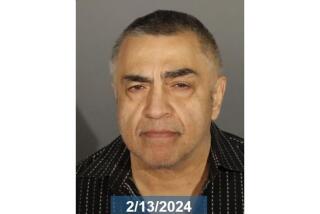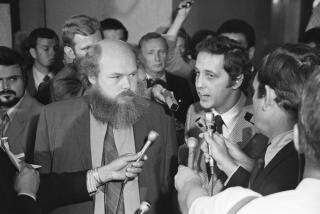Murder, Conspiracy Trial Opens : Courts: Jurors hear opening statements in bizarre case dating to 1988 involving insurance fraud and a mysterious corpse.
- Share via
On this much the prosecution and defense agree: The body found exactly seven years ago this week in a Glendale doctor’s office was not that of Melvin Eugene Hanson, also known as Wolfgang Eugene von Snowden.
Lawyers for both sides also agree that Hanson’s death was staged as part of an insurance scam involving Dr. Richard Boggs, a Harvard-educated, Rolls Royce-driving neurosurgeon now serving a life prison sentence for murder.
But whether the corpse in question was the result of murder or mere cadaver-snatching was the mystery presented to a Superior Court jury in Los Angeles on Monday as lawyers gave opening statements in a murder-conspiracy case both baffling and bizarre.
“The crux of our case is, there was no murder,” defense attorney Joan Whiteside Green asserted. Certainly not that of Hanson. As another defense attorney, Henry Hall, pointed out, Hanson was “alive and well and sitting at the defense table.”
Actually, that’s another thing all involved agree on: The body identified as Hanson’s in fact belonged to Ellis Greene, a 37-year-old North Hollywood bookkeeper.
Deputy Dist. Atty. Al MacKenzie told the jury that the trial will unfold, chapter by chapter, like a book. He contends that Boggs, Hanson and John Barrett Hawkins conspired to murder a stranger--Greene--then pass off his body as Hanson’s to collect $1.5 million in life insurance.
It was “a very sophisticated, well-planned scheme,” and the $1 million paid to Hawkins, the policy’s beneficiary, has never been recovered, MacKenzie told the jury.
How Boggs got his hands on Greene’s corpse is the central issue in this trial.
“Only Dr. Boggs knows what happened,” defense attorney Hall said. “He could become the single most important witness in this case.”
The defense has not, however, given notice that it intends to subpoena Boggs as a witness--and neither has the prosecution. But the possibility that he might testify led to a brief legal skirmish out of the jury’s presence Monday. The defense protested that prosecutors had not disclosed that they had interviewed Boggs, who has been serving a life sentence in state prison since he was convicted in 1990 of Greene’s murder.
The defense attorneys for Hanson and Hawkins say their figurative book is nearly the same as the prosecutor’s--except for the final chapter.
The defense claims that the two defendants, partners in a sportswear company called Just Sweats in Columbus, Ohio, agreed only to pay Boggs to supply a corpse.
Nobody asked Boggs to kill anyone, the defense asserts.
And, they contend, there is absolutely no proof at all that anyone was murdered because the results of an autopsy on Greene’s body are open to interpretation.
“They went to Dr. Boggs to secure a body, a cadaver,” said defense attorney Whiteside Green. “There was no plan to harm another human being. The plan was only to secure a cadaver from a hospital or a morgue.”
“It’s distasteful,” she acknowledged, “it’s clearly unlawful, but it is not a murder case.”
Hall said that by 1987, Hanson had grown tired of Just Sweats, and was looking for a way out even though business was booming. Hanson agreed to stage his death and split the insurance money with Hawkins to keep the business afloat, but it took Boggs months to make good on his promise to deliver a corpse, Hall said.
The agreed-upon price: $25,000 up front, with another $25,000 due on delivery, he said.
Finally, on April 16, 1988, Boggs dialed 911, and reported that one of his patients, Hanson, had died in his office. Hanson’s birth certificate and credit cards were found on the body.
Initially, the Los Angeles County coroner ruled that the dead man, who was HIV-positive and whose blood alcohol level was a staggering .29%, had died of natural causes. The body, presumably that of Hanson, showed signs of ulcers and liver disease.
Hawkins flew in from Ohio, had the remains cremated, then returned to the business. After the autopsy report listed Hanson’s death by natural causes, he filed his insurance claims.
Five months later, after $1 million had been paid, fingerprints confirmed that the body was that of Greene, who’d been reported missing by his aunt.
Friends told police they’d seen Greene drinking at several bars the evening of April 15. One said he received a phone call from a “stressed”-sounding Greene shortly before midnight.
The coroner, at the request of police, reopened the file. The cause of death is unknown, but murder is suspected, the revised coroner’s file stated.
Prosecutors hired Dr. Michael Baden, a nationally renowned forensic pathologist from New York. Baden concluded after viewing lab samples and photographs that Greene had been suffocated.
By then, Hanson and Hawkins had disappeared.
The trail led from suburban Glendale to Columbus, to Miami, and then to Mexico, the Caribbean and beyond. It included appeals for help on TV’s “America’s Most Wanted” and “The Oprah Winfrey Show.”
Hanson became a fixture in Miami’s gay community, using his pseudonym, Wolfgang Eugene von Snowden, authorities have said. He had plastic surgery and hair transplants, and was still recovering when he was arrested at the Dallas-Ft. Worth Airport in 1991 as he stepped off a plane from Acapulco.
Hawkins changed names and appearance so many times that police dubbed him “the Chameleon.”
Hawkins lived an enviable lifestyle until August, 1991, when he was nabbed aboard his catamaran, the Carpe Diem, off Sardinia. He’d been turned in by a Dutch girlfriend who’d seen the Oprah show and was enraged by the disclosure of Hawkins’ other lovers.
Unlike Hanson, who had the misfortune to be apprehended in Texas, Hawkins does not face the death penalty if convicted of first-degree murder. The Italian government refused to extradite him unless prosecutors agreed not execute him.
More to Read
Sign up for Essential California
The most important California stories and recommendations in your inbox every morning.
You may occasionally receive promotional content from the Los Angeles Times.









